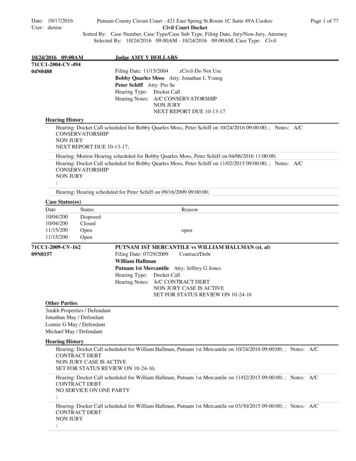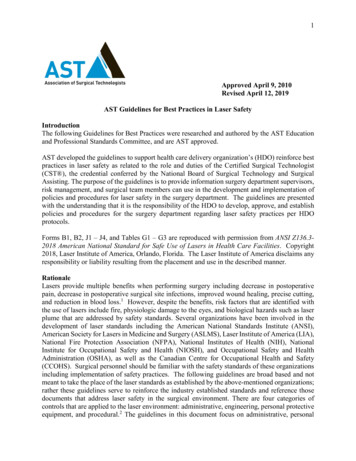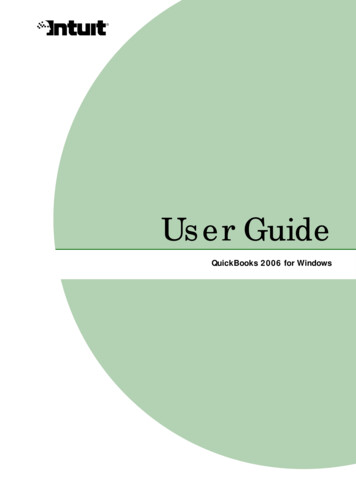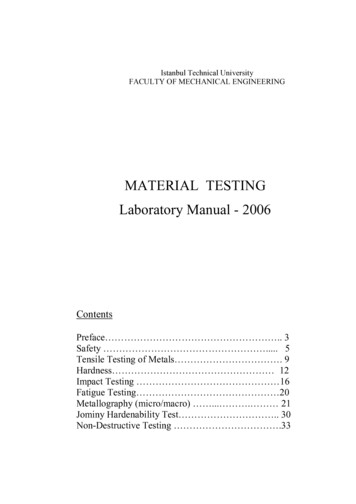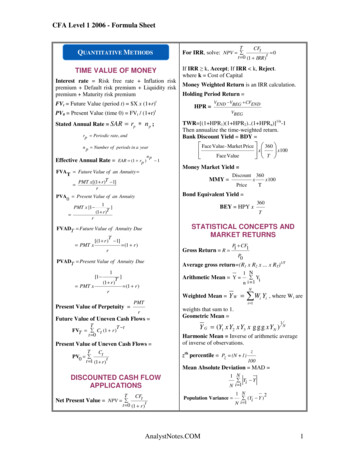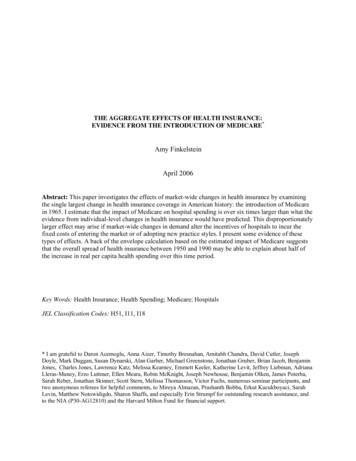
Transcription
THE AGGREGATE EFFECTS OF HEALTH INSURANCE:EVIDENCE FROM THE INTRODUCTION OF MEDICARE*Amy FinkelsteinApril 2006Abstract: This paper investigates the effects of market-wide changes in health insurance by examiningthe single largest change in health insurance coverage in American history: the introduction of Medicarein 1965. I estimate that the impact of Medicare on hospital spending is over six times larger than what theevidence from individual-level changes in health insurance would have predicted. This disproportionatelylarger effect may arise if market-wide changes in demand alter the incentives of hospitals to incur thefixed costs of entering the market or of adopting new practice styles. I present some evidence of thesetypes of effects. A back of the envelope calculation based on the estimated impact of Medicare suggeststhat the overall spread of health insurance between 1950 and 1990 may be able to explain about half ofthe increase in real per capita health spending over this time period.Key Words: Health Insurance; Health Spending; Medicare; HospitalsJEL Classification Codes: H51, I11, I18* I am grateful to Daron Acemoglu, Anna Aizer, Timothy Bresnahan, Amitabh Chandra, David Cutler, JosephDoyle, Mark Duggan, Susan Dynarski, Alan Garber, Michael Greenstone, Jonathan Gruber, Brian Jacob, BenjaminJones, Charles Jones, Lawrence Katz, Melissa Kearney, Emmett Keeler, Katherine Levit, Jeffrey Liebman, AdrianaLleras-Muney, Erzo Luttmer, Ellen Meara, Robin McKnight, Joseph Newhouse, Benjamin Olken, James Poterba,Sarah Reber, Jonathan Skinner, Scott Stern, Melissa Thomasson, Victor Fuchs, numerous seminar participants, andtwo anonymous referees for helpful comments, to Mireya Almazan, Prashanth Bobba, Erkut Kucukboyaci, SarahLevin, Matthew Notowidigdo, Sharon Shaffs, and especially Erin Strumpf for outstanding research assistance, andto the NIA (P30-AG12810) and the Harvard Milton Fund for financial support.
Over the last half-century, the dramatic rise in medical expenditures has been one of the most salientfeatures of the U.S. health care sector. Total health care expenditures in the United States as a share ofGDP have more than tripled, from about 5 percent in 1960 to about 16 percent in 2004 [CMS 2004].Early work by Feldstein [1971, 1977] suggested that the spread of health insurance was a primary causeof the rapid rise in health spending. Such arguments prompted the undertaking of the Rand HealthInsurance Experiment, one of the largest randomized, individual-level social experiments ever conductedin the United States, to investigate the impact of health insurance on health care utilization and spending[Manning et al. 1987]. Its findings suggested that the responsiveness of health spending to healthinsurance was substantially smaller than what Feldstein [1971, 1977] had estimated, and consequently,that the spread of health insurance was not an important cause of the rise in health spending (Manning etal. [1987], Newhouse et al. [1993], Newhouse [1992]). Today, the results of the Rand Experiment aregenerally accepted as the gold standard, and are widely used in both academic and applied contexts(Cutler and Zeckhauser [2000], Zweifel and Manning [2000]).This paper revisits this debate and suggests that the spread of health insurance may have played amuch larger role in the growth of health spending than the Rand Experiment would suggest. The basicinsight is that market-wide changes in health insurance may have fundamentally different effects on thehealth care sector than what partial equilibrium analyses such as the Rand Experiment would suggest.To study the impact of market-wide changes in health insurance, I examine the impact of theintroduction of Medicare in 1965. Medicare’s introduction constituted the single largest change in healthinsurance coverage in American history. Medicare is currently one of the largest health insuranceprograms in the world, providing health insurance to 40 million people and comprising one-eighth of thefederal budget and 2 percent of GDP (National Center for Health Statistics [2002], Newhouse [2002], USCongress [2000]). Yet we know surprisingly little about the impact of its introduction. Indeed, to myknowledge, the only existing evidence comes from a comparison of time series patterns of healthexpenditures before and after its introduction [Feldstein and Taylor 1977].I use the fact that the elderly in different regions of the country had very different rates of private1
health insurance coverage prior to Medicare to identify its effect. I study the impact of Medicare on thehospital sector. This was the single largest component of health spending at the time of Medicare’sintroduction and of the subsequent growth in health spending. My estimates suggest that, in its first fiveyears, the introduction of Medicare was associated with an increase in spending that was over six timeslarger than what the estimates from the Rand Health Insurance Experiment would have predicted. Theyalso suggest that the long-term impact of Medicare may have been even larger than its five-year impact.One reason why the general-equilibrium impact of a market-wide change in health insurance may bemuch larger than what partial-equilibrium analysis would suggest is that market-wide changes in healthinsurance can fundamentally alter the nature and character of medical practice in ways that small-scalechanges will not. Consistent with this, I find that the introduction of Medicare is associated withsubstantial new hospital entry. I also find some suggestive evidence that Medicare’s introduction isassociated with increased adoption of cardiac technologies and increased spending on non-Medicarepatients; however due to data limitations discussed below, these results are necessarily more speculativein nature than the other findings of the paper.Extrapolation from the Rand estimates of the impact of health insurance on health spending suggeststhat the overall spread of health insurance between 1950 and 1990 can explain only a very small part ofthe six-fold rise in real per capita health spending over this period (Manning et al. [1987], Newhouse[1992]). The results of the same exercise using my estimated impact of Medicare suggest that the spreadof health insurance may be able to explain half of the increase in health spending over this period. Ofcourse, important concerns about external validity suggest that the findings of each of these back of theenvelope calculations should be viewed with considerable caution. Nonetheless, at a broad level, myfindings raise the possibility that the spread of health insurance – and the public policies that encouragedit – may have played a much larger role in the substantial growth in the health care sector over the lasthalf century than the current conventional wisdom suggests. At the same, however, my findings are notinconsistent with the conventional wisdom that technological change is the primary cause of the rapid risein health expenditures (e.g. Newhouse [1992], Fuchs [1996], and Cutler [2003]). The large impact of2
market-wide changes in health insurance on health spending may stem in part from their impact ondecisions to adopt new medical technologies, as conjectured by Weisbrod [1991].A complete picture of the impact of an aggregate change in health insurance requires anunderstanding not only of its impact on the health care sector – the subject of this paper – but also of itsbenefits to consumers. In related work, Finkelstein and McKnight [2005] explore these potential benefits.We find that while the introduction of Medicare appears to have had no impact on elderly mortality in itsfirst ten years, it did substantially reduce the right tail of out of pocket medical spending by the elderly.The rest of the paper proceeds as follows. Section one describe the data and empirical strategy.Section two presents estimates of the effect of Medicare on the hospital sector. Section three shows thatthese estimates are substantially larger than what existing partial equilibrium estimates would havepredicted; it also presents some evidence in support of the likely explanations. Section four provides aback of the envelope calculation for what the estimates imply for the contribution of the spread of healthinsurance to the growth of the health care sector over the last half century. The last section concludes.I. Studying the impact of Medicare: Approach and DataI.A. Identifying the impact of Medicare: geographic variation in pre-Medicare insurance coverageMedicare, enacted July 1 1965 and implemented July 1 1966, provided universal public healthinsurance coverage for the elderly. It covered hospital and physician expenses; the services covered andthe reimbursement rates were very generous for the time (Somers and Somers [1967], Newhouse [2002]).Prior to Medicare, public health insurance coverage was practically non existent, and meaningfulprivate health insurance for the elderly was also relatively rare (Stevens and Stevens [1974], United StatesSenate [1963], Anderson and Anderson [1967], and Epstein and Murray, [1967]). Based on data from the1963 National Health Survey (NHS), I estimate that in 1963, only 25 percent of the elderly hadmeaningful (i.e. Blue Cross) private hospital insurance.1 Upon the implementation of Medicare, hospitalinsurance coverage for the elderly rose virtually instantaneously to almost 100 percent [US HEW, 1969].1Most private insurance at this time was extremely minimalist in nature, but Blue Cross plans had relativelycomprehensive coverage (e.g. Anderson et al. [1963], Stevens and Stevens [1974]). For more information on the1963 NHS, see NCHS [1964]. I am extremely grateful to Will Dow for his work unearthing these data.3
The impact of Medicare on elderly insurance coverage varied considerably across the country.Through a special request, I obtained a version of the 1963 NHS that identifies in which of the 11subregions the individual is located. Broadly speaking, insurance coverage for the elderly is higher in theNorth East and North, and lower in the South and West. Table I indicates that the proportion of theelderly without Blue Cross hospital insurance ranged from a low of 49 percent in New England to a highof 88 percent in the East South Central United States. The available data suggest that this geographicpattern was quite stable in the years prior to Medicare (see National Center for Health Statistics [1960]).A key criterion for using geographic variation in private insurance coverage for the elderly to identifythe impact of Medicare is that this insurance was redundant of what Medicare subsequently covered.Consistent with this, Lichtenberg [2002] and Finkelstein and McKnight [2005] present evidence of asubstantial crowd-out effect of Medicare’s introduction on private health insurance spending. The abilityto identify Blue Cross insurance is also particularly important in this regard, as Medicare’s benefit andreimbursement structure was explicitly modeled on the Blues (Anderson et al. [1963], Ball [1995],Epstein and Murray [1967], Newhouse [2002], Stevens and Stevens [1974], and Stevens [1999]).I.B. Data: The American Hospital Association Annual SurveyI use 26 years of hospital-level data from the annual surveys of the American Hospital Association(AHA) for every AHA-registered hospital in the U.S. These data, which are available in hard-copy in theannual August issues of Hospitals: The Journal of the American Hospital Association, cover the yearsfrom 1948 to 1975 (with the exception of 1954). The AHA data from the 1980s and later have beenwidely used to study the hospital sector (e.g. Baker and Phibbs [2002], Cutler and Sheiner [1998]).However, the historical data have been largely ignored.I exclude the approximately five percent of hospitals that are federally owned, producing a sample ofabout 6,500 hospitals per year. The analysis centers on six hospital outcomes: total expenditures, payrollexpenditures, employment, beds, admissions and patient days. Utilization and bed data are exclusive ofnewborns. I convert all expenditure variables to 1960 dollars using the CPI-U. Hospital expendituresconsist of expenditures on inputs, and do not reflect hospital output prices. Employment and payroll4
expenditures exclude most physicians, since they are not employed directly by the hospital. Appendix Aprovides a more detailed description of these variables and of the data quality.Figure I shows the national time series patterns for each outcome based on aggregating the hospitallevel data to the national level. Most outcomes are increasing over the entire sample period. However,beds and patient days began decreasing in the early 1960s as short-term hospitals took over many of thefunctions previously performed by long-term hospitals, such as treatment of tuberculosis patients [Somersand Somers 1967]; prior to this decline, long-term hospitals constituted above 10 percent of hospitals, buthalf of beds and patient days.Table II reports mean hospital outcomes prior to Medicare (1962-1964). It shows that prior toMedicare, average hospital outcomes were consistently higher in the North and NorthEast (whereinsurance coverage was comparatively high) than in the South and West (where insurance coverage wascomparatively low). This is consistent with the evidence in the paper of an impact of insurance coverageon these outcomes, but may also reflect other differences across regions.II. The Impact of Medicare on Hospital Utilization, Inputs and SpendingII.A. Econometric modelThe empirical strategy is to compare changes in outcomes in regions of the country where Medicarehad a larger effect on the percentage of the elderly with health insurance to areas where it had less of aneffect. Since this approach will not capture any effect of Medicare on the previously-insured that operatesvia Medicare’s income effect, it will underestimate the full impact of Medicare.Of course, private insurance rates prior to Medicare are not randomly assigned. Data from the 1960census indicate that differences in socio-economic status can explain a substantial share of the variation ininsurance coverage across subregions. Areas that differ in their socio-economic status may also differ intheir desired level or growth of health care utilization and spending. The empirical approach is thereforeto look at whether there is a break in any pre-existing differences in the level or trend of these outcomesaround the time of Medicare’s introduction in 1966. The identifying assumption is that absent Medicare,any pre-period differences would have continued on the same trends.5
The basic estimating equation is:(1)log( y ijt ) α j * 1(county j ) δ t * 1(Yeart ) t 1975 λ (Mcareimpactt 1948tz) * 1(Yeart ) X st β ε ijt .The dependent variable is the log of outcome y in hospital i in county j and year t; a level specificationwould constrain the outcomes to grow by the same absolute amount each year, which would beinappropriate given the considerable variation in size across hospitals. 1(Countyj ) are county fixedeffects; these control for any fixed differences across counties. 1(Yeart ) are year fixed effects; thesecontrol for any nationwide year effects. Mcareimpactz measures the percentage of the elderly in subregionz without private Blue Cross hospital insurance in 1963 (see Table I).To account for possible serial correlation over time within areas, I allow for an arbitrary variancecovariance matrix in the error structure within each hospital market. 2 The existing literature suggests theuse of the standard metropolitan statistical area (SMSA), defined in 1960, to approximate the hospitalmarket (see e.g. Makuc et al. [1991], Gaynor and Vogt [2000], and Dranove et al. [1992]). This produces210 separate markets; I also include 50 additional markets for the rural (non-SMSA) areas in each state.The key variables of interest are the interactions of the year fixed effects with Mcareimpactz( ( Mcareimpact z ) * 1(Yeart ) ). The pattern of coefficients on these variables – the λt ' s – shows theflexibly estimated pattern over time in the dependent variable in areas where Medicare had a largerimpact on insurance coverage relative to areas where it had a smaller impact. The change in the trend ofthese λt ' s before and after the introduction of Medicare provides an estimate of Medicare’s impact.Crucially, equation (1) does not privilege 1965 relative to other years. Because I do not impose any exante restrictions on when any structural breaks may occur, I allow the data to show where changes in thetime pattern – if any – actually occur, and can gauge whether Medicare may plausibly have played a role.To alleviate concerns that other things might also have been changing differentially over time across2Clustering at the market level allows for directly comparability of these results with those of subsequent analysesestimated at the market level. In practice, however, p-values are very similar if I instead cluster at the state level (seeFinkelstein [2005]), or implement the randomized inference procedure described by Bertrand et al. [2004].6
different areas of the country, equation (1) also includes a series of time-varying state-level covariates( X st ). Of particular concern is the potential confounding impact of Medicaid which, like Medicare, wasalso enacted in 1965. Medicaid accounted for less than one-third of combined Medicare and Medicaidhospital spending in the early 1970s [National Center for Health Statistics 2002].Because the timing of Medicaid implementation – unlike Medicare – was left up to the individualstates, I can try to separately control for any impact of Medicaid.3 In all of the analyses, I thereforeinclude a series of eight indicator variables for the number of years since (or before) the implementationof a Medicaid program in state s.4 In practice, the estimated effects of Medicare are not sensitive toincluding these controls for Medicaid implementation. Of course, even controlling for the timing ofMedicaid’s introduction, equation (1) may overestimate the impact of Medicare if the size of a state’sMedicaid program is positively correlated with Mcareimpactz. In practice, however, there is a weaknegative correlation between Medicaid spending per capita and Mcareimpactz, reflecting the fact thatstates in the North and Northeast implemented more generous Medicaid programs (U.S. Department ofHealth, Education and Welfare [1968], Stuart [1972]).Finally, it is important to highlight two limitations to using the results from equation (1) to gauge theaggregate impact of Medicare on national spending and utilization. First, hospital units of varying size aregiven equal weight in the estimation, but might have different responses to Medicare. Second, estimationat the hospital level may not capture any impact of Medicare that occurs via an effect on hospital entryand exit. Therefore when I turn to the aggregate impact of Medicare in section II.D below, I presentadditional results aggregated to the hospital market level – which captures any net effects of hospital entryand exit – and weighted by market size. I also directly investigate the impact of Medicare on hospital3By July 1, 1966 (the date that Medicare was implemented) 22 states – accounting for half the national population –had implemented Medicaid. By January 1967 26 states (62 percent of the population) had implemented Medicaid.These numbers increased to 37 states (77 percent of the population) by January 1968, 40 states (80 percent of thepopulation) by January 1969, and 49 states (99 percent of the population) by January 1970 (US Department ofHealth, Education and Welfare [1970], Gruber [2003] and population estimates from the 1960 census).4Although in principle, estimates of equation (1) could shed light on the impact of Medicaid, in practice, the resultssuggest that the timing of state implementation of Medicaid was not random with respect to hospital outcomes, andanalysis does not yield stable estimates of the impact of Medicaid.7
entry and exit in section III.B.5II.B. Basic ResultsThe core empirical findings are readily apparent in Figure II, which shows the λt’s from estimatingequation (1) for six (log) dependent variables: admissions, patient days, employment, beds, payrollexpenditures, and total expenditures. The time pattern of the λt ' s identifies changes in the dependentvariable in areas in which Medicare had a larger impact on insurance coverage relative to areas in whichMedicare had a smaller impact. The dashed lines indicate the 95 percent confidence interval for eachcoefficient, which naturally increases with the distance from the reference year 1963. A vertical linedemarcates 1965, the year in which Medicare was enacted.6Consider first the results for hospital admissions (the upper-left graph in Figure II). There is a generaldownward trend over time in the λt ' s up through 1965. This indicates that, prior to 1965, hospitaladmissions were not growing as fast in low insurance areas relative to high insurance areas. However,there is a dramatic reversal in this pattern after 1965, at which point admissions start to grow at the samerate or faster in the areas where Medicare’s introduction had a larger impact on insurance coverage. Theother five hospital outcomes examined in Figure II show the same pattern of a dramatic reversal of agenerally downward or flat trend after 1965. The estimates for payroll and total expenses are somewhatnoisier than the other estimates, which may reflect the greater noise in the expenditure measures (seeAppendix A). The existence of a prior relative trend across more and less affected areas is not surprisinggiven the differences across these areas in the level of hospital activity (and other characteristics) prior toMedicare, although the sign of this relative trend was not obvious a priori.Motivated by the graphical results, I perform a variety of statistical tests of the n-year change inλt after the introduction of Medicare relative to the n-year change in λt before the introduction of5As I discuss below, estimation at the market level has its own disadvantage, namely increased noise in aggregatedsums due to non-trivial amounts of missing data.6Data from year t are from the survey period October (t-1) to September (t). Since Medicare was enacted in July1965 and implemented in July 1966, the year 1965 (i.e. Oct 1964 to Sept 1965) is treated as the year prior toMedicare. Any effects detected in 1966 (i.e. Oct 1965 to Sept 1966) may be anticipation or actual effects.8
Medicare. For example, the impact of Medicare in the first five years is calculated as follows:(2)Δ5 (λ1970 λ1965 ) (λ1965 λ1960 ) .Δ5 thus denotes the five-year change in the hospital outcome after the introduction of Medicare relativeto the five-year change prior to the introduction of Medicare in areas where Medicare had a greaterimpact on insurance coverage relative to areas where it had a smaller impact. The first three rows of TableIII report the estimates for the two-year, five-year and ten-year change in the outcome, respectively; pvalues are reported in parentheses below each estimate. The results indicate that the introduction ofMedicare is associated with a statistically significant increase in all of the dependent variables.Because the reference (or pre-) period varies across the two-year, five-year, and ten-year tests,comparisons across the tests should not be interpreted as different effects at different time intervals. Tocompare the effects in different time intervals, the fourth row of Table III repeats the five-year test in thesecond row for the second five year period 1970 to 1975, using the same reference period (1965 to 1960)as the first five year test. The results indicate that Medicare is associated with a further statisticallysignificant increase in all of the outcomes in the second five year period.The results from the first five-year test indicate an effect of Medicare for log admissions of 0.504, andfor log total expenditures of 0.332. To translate these into the implied national impact of Medicare, Imultiple them by 0.75, since nationwide, Medicare increased the proportion of the elderly with insurancecoverage by 75 percentage points. The results therefore imply that the introduction of Medicare isassociated with a nationwide increase between 1965 and 1970 in admissions and total spending of,respectively, 46 percent ( [exp(0.504 x 0.75)-1]), and 28 percent ( [exp(0.332 x 0.75)-1]). In SectionII.D below, I discuss some limitations to using the results in Table III to estimate the implied nationalimpact of Medicare, and present and discuss some alternative estimates.II.C. RobustnessI investigated the robustness of the preceding results to a number of alternative specifications. Overallthe results were quite robust. This section briefly summarizes some of the more important robustness9
tests. Many of the results are presented in Table IV, where, to conserve space, I only report the five-yearestimates. To make the results comparable across different specifications, I present the implied five-yearimpact of Medicare. Row 1 therefore takes the baseline results from Table III and multiplies them by 0.75since, nationwide, Medicare increased the percent of the elderly by 75 percentage points.A primary concern is the validity of the identifying assumption that absent the introduction ofMedicare, the different subregions of the country would not have exhibited divergent growth from thepre-Medicare patterns. Figure II suggests that in no year prior to 1965 (or after it for that matter) is thereevidence of the dramatic reversal in trend in all outcomes that occurs after 1965. To examine this moresystematically, I limit the data to the years prior to 1966 and re-estimate equation (1) and the two-yearand five-year tests from Table III if – counter to fact – I assign some year prior to 1966 as the year inwhich Medicare was implemented. I tend not to find statistically or substantively large effects from these“false tests”, which is broadly supportive of the identifying assumption (see Finkelstein [2005] forresults). Further supporting the identifying assumption, row 2 of Table IV shows that the results arerobust to including state-specific linear trends in equation (1), and row 3 shows that the results are robustto including additional time-varying covariates for real per capita state income, state infant mortality rate,the rate of violent crime and state population.7 Finally, since the introduction of Medicare coincided witha period of enormous social upheaval in the South, – including the civil rights movement and the HillBurton hospital construction program – row 4 shows that the results are robust to excluding the foursouthern subregions (about one-third of hospitals) from the sample. More generally, the results are robustto omitting any given subregion from the sample (see Finkelstein [2005] for results).A related concern is that the estimated impact of Medicare might in part reflect the impact ofincreases in private health insurance for other age groups. However, I find no indication in the 1959, 1963and 1970 NHS surveys of a relative increase in non-elderly private health insurance after Medicare’sintroduction relative to before in the more affected census regions relative to less affected census regions.7I am grateful to Larry Katz for providing these data. All variables are measured annually, except state populationwhich is interpolated between censuses. See Katz, Levitt, and Shustorovitch [2003] for more details.10
A final set of sensitivity analyses uses alternative sources of cross-sectional heterogeneity in theimpact of Medicare on insurance coverage. Row 5 shows that the results are robust to using variation ininsurance coverage at the subregion by-urban or subregion by-rural level instead of just variation at thesubregion level.8 Row 6 shows that the results are robust to replacing the linear measure of Mcareimpactzwith an indicator variable for whether the subregion is one of the eight subregions above the nationalaverage in the impact of Medicare on insurance coverage. Row 7 shows the results are robust tomeasuring Mcareimpactz by the percent of elderly without any hospital insurance, rather than withoutBlue Cross hospital insurance (see Table I). Finally, row 8 shows that the results are quite similar ifMcareimpactz is measured as the share of hospital expenditures in the subregion covered by elderlyinsurance, which is calculated as the percent of the elderly without BC insurance times the proportion ofhospital expenses that are elderly.9 This is not surprising since in practice there is very little variation inthe percent elderly across subregions (or even across counties).II.D. The magnitude of the impact of Medicare’s introduction on aggregate spendingThere are two important limitations to using the results from estimating equation (1) at the hospitallevel to infer the aggregate impact of Medicare. First, the analysis will not capture any effects ofMedicare that operate via an impact on hospital exit or entry. Second, the analysis treats hospital ofdifferent size equally, although they may have differential responses to Medicare. This section thereforeestimates alternative models to address both of these potential issues.One way to capture any impact of Medicare that operates via an impact on hospital exit or entry is toaggregate (i.e. sum) the outcomes to the hospital market. The disadvantage of analysis at the market-levelis the increased noise in the estimates due to non-trivial amounts of missing data, particularly for theexpenditure measures where only about two-thirds of hospitals report the information in a given year (see8Insurance rates are uniformly lower in rural areas, but the geographic pattern across subregions is quite similar inrural and in urban
envelope calculations should be viewed with considerable caution. Nonetheless, at a broad level, my findings raise the possibility that the spread of health insurance – and the public policies that encouraged it – may have played a much larger role in the substantial growth



